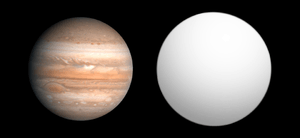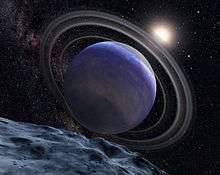HR 8799 b
| Exoplanet | List of exoplanets | |
|---|---|---|
 | ||
| Parent star | ||
| Star | HR 8799 | |
| Constellation | Pegasus | |
| Right ascension | (α) | 23h 07m 28.7150s[1] |
| Declination | (δ) | +21° 08′ 03.302″[1] |
| Apparent magnitude | (mV) | 5.964[1] |
| Distance | 129 ± 4[2][note 1] ly (39 ± 1[2][note 1] pc) | |
| Spectral type | kA5 hF0 mA5 V; λ Boo[3][4] | |
| Observed separation Observation epoch 2008-09-18 | ||
| Angular separation | (ρ) | 1724[5][note 2] mas |
| Position angle | (θ) | 62.42[5][note 2]° |
| Projected separation | (d) | 68[5] AU |
| Orbital elements | ||
| Semi-major axis | (a) | ~ 68[5][note 3] AU (~ 10000 Gm) |
| Orbital period | (P) | ~ 460[5][note 3] y |
| Physical characteristics | ||
| Mass | (m) | 5+2 −1[6] MJ |
| Radius | (r) | 1.2 ± 0.1[5] RJ |
| Density | (ρ) | 2.91+1 −0.7 kg m−3 |
| Temperature | (T) | 870+30 −70[5] |
| Discovery information | ||
| Discovery date | November 13, 2008 | |
| Discoverer(s) | Marois et al. | |
| Discovery method | Direct imaging | |
| Discovery site | Keck and Gemini observatories in Hawaii | |
| Discovery status | Published | |
| Other designations | ||
| Database references | ||
| Extrasolar Planets Encyclopaedia | data | |
| SIMBAD | data | |
| Exoplanet Archive | data | |
| Open Exoplanet Catalogue | data | |
HR 8799 b is an extrasolar planet located approximately 129 light-years away in the constellation of Pegasus, orbiting the 6th magnitude Lambda Boötis star HR 8799. It has a mass between 4 and 7 [6]Jupiter masses and a radius from 10 to 30% larger than Jupiter's. It orbits at 68 AU from HR 8799 (or 7 AU inside the inner edge of the dust disk orbiting the star) with an unknown eccentricity and a period of 460 years, and is the outermost known planet in the HR 8799 system. Along with two other planets orbiting HR 8799, the planet was discovered on November 13, 2008 by Marois et al., using the Keck and Gemini observatories in Hawaii. These planets were discovered using the direct imaging technique.[5][8][9][10][11]

In 2009 it was discovered that the Hubble Space Telescope had in fact directly imaged HR 8799 b eleven years earlier, in 1998, suggesting that more exoplanets might be revealed through analysis of HST photographic archives.[12] Additional precovery images were also obtained by reanalyzing data taken in 2002 at the Subaru Telescope and in 2005 and 2007 at the W.M Keck Observatory [13] [14] .[15]
Broadband photometry of HR 8799 b shows that it has thicker clouds in its atmosphere than do older, higher surface gravity substellar objects of the same effective temperature.[16] Near infrared H band and K band spectroscopy of HR8799b published in May 2011 indicate a hydrogen rich, dusty atmosphere with disequilibrium CO / CH4 chemistry.[17]
Near infrared spectroscopy made with the Palomar Obervatory show evidence of ammonia and/or acetylene as well as carbon dioxide, and some methane.[18] In 2015, the signals of water, carbon monoxide and methane were reported in infrared spectra taken at the Keck telescope.[19] However, a reanalysis of the same data in 2018 shows that water and carbon monoxide are present, but that the methane detection may have been spurious. Observations by the James Webb Space Telescope will be capable of confirming or disproving the presence of methane in HR 8799 b's atmosphere.[20]
See also
Notes
References
- 1 2 3 "V* V342 Peg". SIMBAD. Centre de données astronomiques de Strasbourg. Retrieved November 14, 2008.
- 1 2 van Leeuwen, F. (2007). "HIP 114189". Hipparcos, the New Reduction. Retrieved 2008-10-13.
- ↑ Gray, R.O.; Kaye, A.B. (1999). "HR 8799: A Link between γ Doradus Variables and λ Bootis Stars". The Astronomical Journal. 118 (6): 2993–2996. Bibcode:1999AJ....118.2993G. doi:10.1086/301134.
- ↑ Kaye, A.B.; et al. (1999). "Gamma Doradus Stars: Defining a New Class of Pulsating Variables". Publications of the Astronomical Society of the Pacific. 111 (761): 840–844. arXiv:astro-ph/9905042. Bibcode:1999PASP..111..840K. doi:10.1086/316399.
- 1 2 3 4 5 6 7 8 Marois, Christian; Macintosh, Bruce; Barman, Travis; Zuckerman, B.; Song, Inseok; Patience, Jennifer; Lafrenière, David; Doyon, René (November 2008). "Direct Imaging of Multiple Planets Orbiting the Star HR 8799". Science. 322 (5906): 1348–1352. arXiv:0811.2606. Bibcode:2008Sci...322.1348M. doi:10.1126/science.1166585. PMID 19008415.
- 1 2 Marois; Zuckerman; Konopacky; Macintosh; Barman (2010). "Images of a fourth planet orbiting HR 8799". Nature. 468 (7327): 1080–3. arXiv:1011.4918. Bibcode:2010Natur.468.1080M. doi:10.1038/nature09684. PMID 21150902.
- ↑ HD 218396b -- Extra-solar Planet Candidate, entry, SIMBAD. Accessed on line December 6, 2008.
- ↑ "Astronomers capture first images of newly-discovered solar system" (Press release). W. M. Keck Observatory. 2008-11-13. Archived from the original on 2013-11-26. Retrieved 2008-12-02.
- ↑ "Gemini Releases Historic Discovery Image of Planetary First Family" (Press release). Gemini Observatory. 2008-11-13. Retrieved 2008-12-02.
- ↑ Achenbach, Joel (2008-11-13). "Scientists Publish First Direct Images of Extrasolar Planets". The Washington Post. The Washington Post Company. Retrieved 2008-12-02.
- ↑ Fabrycky; et al. (1 December 2008). "Stability of the directly imaged multiplanet system HR 8799: resonance and masses". Astrophys. J. 710 (2): 1408–1421. arXiv:0812.0011. Bibcode:2010ApJ...710.1408F. doi:10.1088/0004-637X/710/2/1408.
- ↑ Lafrenière; et al. (18 February 2009). "HST/NICMOS detection of HR 8799 b in 1998". The Astrophysical Journal. 694 (2): L148–L152. arXiv:0902.3247. Bibcode:2009ApJ...694L.148L. doi:10.1088/0004-637X/694/2/L148.
- ↑ Fukagawa, Misato; Tamura, Motohide; Oasa, Yumiko; Hayashi, Saeko S.; Fujita, Yutaka; Shibai, Hiroshi; Hayashi, Masahiko (July 2012). "H-Band Image of a Planetary Companion Around HR 8799 in 2002". The Astrophysical Journal Letters. 696: 1. arXiv:1206.0483. Bibcode:2009ApJ...696L...1F. doi:10.1088/0004-637X/696/1/L1. Missing
|last2=in Authors list (help) - ↑ Metchev, Stanimir; Zuckerman, B. (November 2009). "Pre-Discovery 2007 Image of the HR 8799 Planetary System". The Astrophysical Journal Letters. 696 (2): 1. arXiv:0910.0915. Bibcode:2009ApJ...705L.204M. doi:10.1088/0004-637X/705/2/L204. Missing
|last2=in Authors list (help) - ↑ Currie, Thayne; Thalmann, Christian; Matsumura, Soko; Plavchan, Peter (July 2012). "Direct Detection and Orbital Analysis of the Exoplanets HR 8799 bcd from Archival 2005 Keck/NIRC2 Data". The Astrophysical Journal Letters. 755 (2): 34. arXiv:1206.0483. Bibcode:2012ApJ...755L..34C. doi:10.1088/2041-8205/755/2/l34. Missing
|last2=in Authors list (help) - ↑ Currie, Thayne; Itoh, Yoichi; Matsumura, Soko; Fukagawa, Misato; Apai, Daniel; Madhusudhan, Nikku; Hinz, Philip M.; Rodigas, T. J.; Kasper, Markus; Pyo, T.-S.; Ogino, Satoshi (March 2011). "A Combined Subaru/VLT/MMT 1--5 Micron Study of Planets Orbiting HR 8799: Implications for Atmospheric Properties, Masses, and Formation". The Astrophysical Journal. 729 (2): 128. arXiv:1101.1973. Bibcode:2011ApJ...729..128C. doi:10.1088/0004-637x/729/2/128. Missing
|last2=in Authors list (help) - ↑ Barman, Travis S.; Macintosh, Bruce; Konopacky, Quinn M.; Marois, Christian (2011-03-20). "Clouds and Chemistry in the Atmosphere of Extrasolar Planet HR8799b". The Astrophysical Journal. 733: 65. arXiv:1103.3895. Bibcode:2011ApJ...733...65B. doi:10.1088/0004-637X/733/1/65.
- ↑ Oppenheimer, B. R. (2013). "Reconnaissance of the HR 8799 Exosolar System I: Near IR Spectroscopy". The Astrophysical Journal. Cornell University. 768: 24. arXiv:1303.2627. Bibcode:2013ApJ...768...24O. doi:10.1088/0004-637X/768/1/24.
- ↑ Barman, Travis S.; Konopacky, Quinn M.; Macintosh, Bruce; Marois, Christian (4 May 2015). "Simultaneous detection of water, methane, and carbon monoxide in the atmosphere of exoplanet HR 8799 b". The Astrophysical Journal. 804: 61. arXiv:1503.03539. Bibcode:2015ApJ...804...61B. doi:10.1088/0004-637X/804/1/61.
- ↑ Petit dit de la Roche, D. J. M.; Hoeijmakers, H. J.; Snellen, I. A. G. (31 August 2018). "Molecule mapping of HR8799b using OSIRIS on Keck: Strong detection of water and carbon monoxide, but no methane". The Astrophysical Journal. 616: A146. arXiv:1808.10790. Bibcode:2018A&A...616A.146P. doi:10.1051/0004-6361/201833384.
External links
![]()
- "HR 8799 b". Exoplanets.